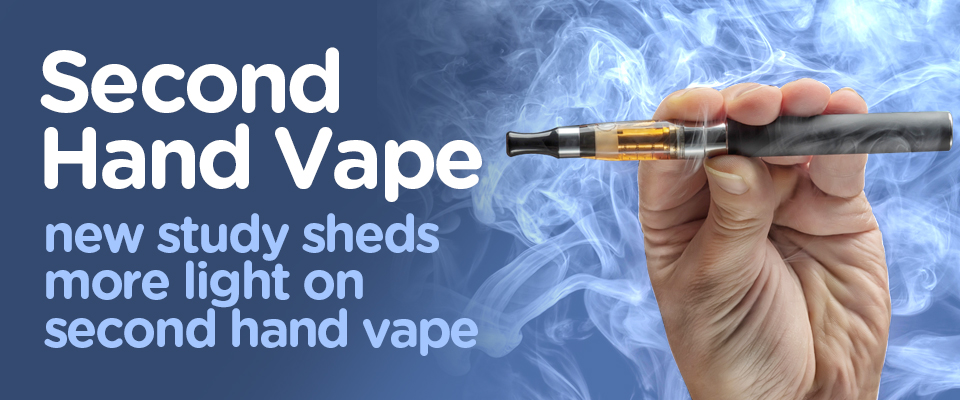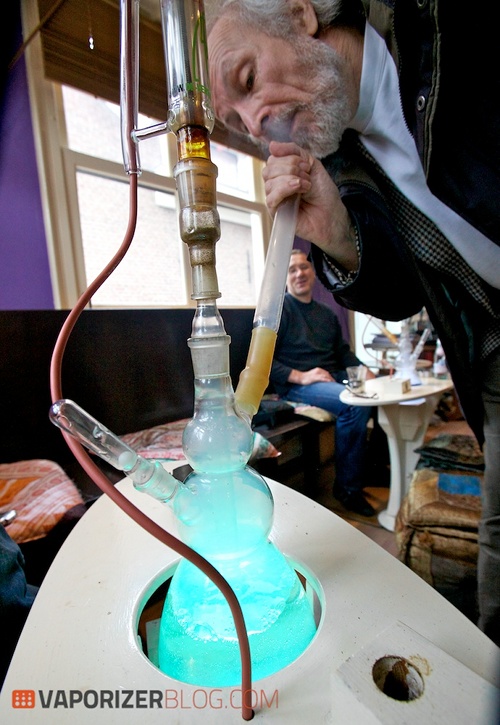
Is secondhand vape aerosol harmful?
Feb 01, 2020 · Formaldehyde: This is a compound created when solvents like propylene glycol and glycerin are heated up by the vaping device. It’s readily absorbed by the lungs and can be toxic—possibly even cancer-causing—in high doses. 3. Acrolein: This is a compound made when glycerin is heated by the coils in an e-cigarette.
Is secondhand vape smoke from vapers real?
Nov 27, 2019 · Nicotine. Ultrafine particles that can be inhaled deep into the lungs. Flavor additives such as diacetyl, a chemical linked to serious lung disease. Heavy metals, such as nickel, tin and lead. Formaldehyde (embalming fluids) Benzene (found in car exhausts) “There’s also this fear of the unknown,” admits Dr. Nakhleh.
What is secondhand vapor and how does it affect me?
This produces carcinogenic particles including tar, carbon monoxide and other cancer-causing chemicals. Vape clouds are a product of heating e- juice with a metal vape coil that is typically housed in an atomizer. So does this mean second hand vapor is not dangerous? Let’s look at some studies. Studies on Vaping and Second Hand Aerosol
Is secondhand smoke from vapes harmful to children?
Sep 03, 2019 · Vegetable glycerin produces the visible aerosol, or cloud, seen when vaping. It's made from vegetable oil. Propylene glycol is a clear, …

How does an e-cigarette work?
E-cigarette devices use metal coils to heat the vaping fluid, and over time, small amounts of metals can sometimes get into the aerosol after repeated use at high temperatures. 6 . While the person vaping will breathe in the full brunt of these toxins, some will be exhaled into the air.
Who is Anju Goel?
Anju Goel, MD, MPH, is a board-certified physician who specializes in public health, communicable disease, diabetes, and health policy. UPDATE: Recent illnesses have been associated with use of e-cigarettes (vaping).
Does vaping hurt your lungs?
Short-term studies didn’t find evidence that secondhand vaping hurts lung function , with one notable exception. Researchers found that people who were around vaping aerosol showed increases in the serum cotinine, which is a marker that someone was exposed to nicotine (an ingredient often found in e-cigarettes). 7 Given the long list of health risks posed by nicotine, more research needs to be done on how this exposure could affect someone’s lungs long-term like it can with secondhand smoke.
Is second hand vaping bad for you?
Secondhand Vaping as a Gateway. In addition to the still uncertain health risks associated with breathing in e-cigarette aerosol, being around people who vape could have other consequences—particularly for adolescents who are more likely to be influenced by social norms and visual cues.
What percentage of kids have food allergies?
According to research, roughly 8% of U.S. kids have food allergies. 8 Nuts (a common food allergy) are sometimes used to make added flavors in vaping fluids. If a child ingests or touches fluids with an allergen in it, they could have a reaction.
Can vaping cause lung injury?
UPDATE: Recent illnesses have been associated with use of e-cigarettes (vaping). Since the specific causes of these lung injury cases are not yet known, the Centers for Disease Control and Prevention (CDC) recommends refraining from all vaping products.
Can you breathe in e-cigarette smoke?
Just like people around smokers can breathe in cigarette smoke, it’s possible to breathe in e-cigarette aerosol if you’re around someone vaping. This is called secondhand vaping, and there isn't a lot of published research yet on how inhaling this aerosol affects the body, especially among adolescents.
Does vaping affect indoor air quality?
But vaping (which was being done in 43 of the homes) had no measurable effect on the indoor air quality. Even studies of the air in vape shops have shown that levels of toxicants are below occupational exposure limits.
Can nicotine be deposited on surfaces?
“Nicotine from exhaled vapour can be deposited on surfaces, but at such low levels that there is no plausible mechanism by which such deposits could enter the body at doses that would cause physical harm,” Royal College of Physicians researchers noted in that organization’s comprehensive 2016 review of e-cigarette science.
Is vaping dangerous?
However, we do know enough about the likely health risks of vaping—based on the safety profiles of the chemicals involved—to understand that vaping almost certainly doesn’t pose risks to users as great as those of combustible cigarettes. We may actually know more about the risks to bystanders than to vapers themselves.
Is second hand smoke dangerous?
Secondhand smoke isn’t as dangerous as inhaling directly from a cigarette, but regular and prolonged exposure to it is considered a serious hazard. E-cigs heat e-liquid with a small metal coil housed in an atomizer, and the heat turns the e-juice into the vapor you see.
What is a vape?
Vapes—short for “vaporizers”—come in all shapes and sizes. Some are smaller and may look like traditional cigarettes or USB storage devices. Others are larger and can look more like a science project than a smoking apparatus. Despite the differences in appearance, the technology behind most vapes is relatively similar.
What is vaping juice?
Most devices are powered by a rechargeable battery that is used to heat the vaping liquid, turning it to an aerosol that vapers then inhale. Vaping liquids, also called e-juice or vape juice, come in a wide range of flavors—many of which may resemble desserts, fruit or candy—and contain varying levels of nicotine.
Why is vaping good?
Vaping advocates promote vaping as a safe alternative to smoking traditional cigarettes for three reasons: 1 There is no combustion, or burning, involved in vaping, meaning that people that vape “smoke” is free of many carcinogens found in cigarette smoke. 2 Vapes do not create the harmful tar that causes cigarettes to be so hazardous to public health. 3 Vape liquids may not contain the wide range of dangerous chemicals present in traditional cigarettes.
When were vapes invented?
Vapes, also called e-cigarettes, were first introduced to consumers as a tobacco alternative in the early 2000s. Manufacturers marketed the product to smokers as a way to inhale nicotine without the cancer-causing tar and other harmful chemicals found in tobacco cigarettes.
Is it safe to eat nicotine?
Some may even contain no nicotine at all. These liquids are typically made up of propylene glycol and vegetable glycerin to vaporize the nicotine. Both compounds are generally recognized as safe for consumption in small amounts, though contact with them may irritate the skin, eyes or respiratory system.
Is vaping a carcinogen?
There is no combustion, or burning, involved in vaping, meaning that people that vape “smoke” is free of many carcinogens found in cigarette smoke. Vapes do not create the harmful tar that causes cigarettes to be so hazardous to public health. Vape liquids may not contain the wide range of dangerous chemicals present in traditional cigarettes.
Is vaping safe in public?
For these reasons touted by vape advocate s and manufacturers, many people feel comfortable vaping in situations where smoking cigarettes would be strictly prohibited, such as inside public buildings and in close proximity to other people. However, secondhand exposure to vaping aerosols may not be as harmless you think.
Studies on Vaping and Second Hand Aerosol
Studies such as a 2017 UC San Diego depict a different message than what has been in the headlines. Researchers went into 193 homes to measure fine particles left behind by smokers and vapers living inside the residence. They found no effect on the air quality due to vaping.
So, is second hand vape dangerous?
Unfortunately, because vaping is still fairly new and long term studies, for the most part, have not been done to state a certain answer, the question of "is second-hand vape bad?" is for now inconclusive.
What are the main components of an e-cigarette?
The main components. E-cigarette liquids, at the bare minimum, have three main components: flavors, sweeteners and solvents. Solvents are substances used to dissolve either nicotine or marijuana-derived compounds including THC or CBD so those ingredients can be inhaled.
What are the ingredients in e-liquid?
Sweeteners include sucralose and ethyl maltol. E-liquid flavors are wide-ranging, and can read like a wine tasting: "notes of vanilla" or "berries and herbal notes.". All of those ingredients — the solvents, the sweeteners and the flavors — are considered "generally recognized as safe" by the Food and Drug Administration.
How do e-cigarettes produce aerosols?
E-cigarettes produce an aerosol by heating the e-liquid with metal coils. Those metal coils can be composed of a variety of substances, including an alloy of iron, chromium and aluminum called kanthal, or a combination of nickel and chromium.
Does propylene glycol cause asthma?
Studies have shown that breathing in aerosolized propylene glycol may contribute to asthma.
What are coils made of?
Those metal coils can be composed of a variety of substances, including an alloy of iron, chromium and aluminum called kanthal, or a combination of nickel and chromium. A Johns Hopkins study released in 2018 found those metals leach into vaping aerosol at dangerous levels.
Is nicotine a carcinogen?
By itself, it's not known to be carcinogenic, but some lab research has suggested nicotine could promote tumor growth.
Does nicotine increase heart rate?
And the American Heart Association says nicotine can cause an increase in blood pressure, heart rate and a narrowing of the arteries, as well as increase the risk of a heart attack.
What chemicals are in vaping?
Vaping exposes the lungs to a variety of chemicals. These may include the main active chemicals in tobacco (nicotine) or marijuana (THC), flavorants, and other ingredients that are added to vaping liquids. Plus, other chemicals can be produced during the vaporizing process.
What are vaping devices?
Vaping devices, also known as e-cigarettes, vape pens, and e-hookahs among other terms, come in many shapes and sizes. Some look like traditional cigarettes, cigars, or pipes. Others are shaped like every-day objects, such as pens or USB memory sticks.
How does puffing work?
While they may look different, most vaping devices work in a similar way. Puffing activates a battery-powered heating device. This heats the liquid in a cartridge, turning it into vapors that are inhaled.
Is vitamin E acetate harmful?
One harmful chemical may be a thickening agent called Vitamin E acetate, which is sometimes used as an additive in THC-containing vape products. The CDC identified it as a “chemical of concern” among people with vaping-associated lung injuries.
How old do you have to be to vape?
New laws are aimed at curbing vaping among teens. People must now be 21 to buy any tobacco product, including vaping products. And companies can no longer produce and sell flavors that appeal to children like fruit and mint. If you’ve already started vaping or smoking cigarettes, it’s never too late to quit.
Is vaping more popular in high school?
Vaping is now more popular among teens than smoking traditional cigarettes. One in four high school seniors say they vaped nicotine in the past month. And studies have found that teens who vape nicotine may be more likely to go on to smoke traditional cigarettes.
Does vaping affect your health?
But nicotine vaping could still damage your health. “Your lungs aren’t meant to deal with the constant challenge of non-air that people are putting into them—sometimes as many as 200 puffs a day—day after day, week after week, year after year,” Eissenberg says. “You’re inhaling propylene glycol, vegetable glycerin, ...
